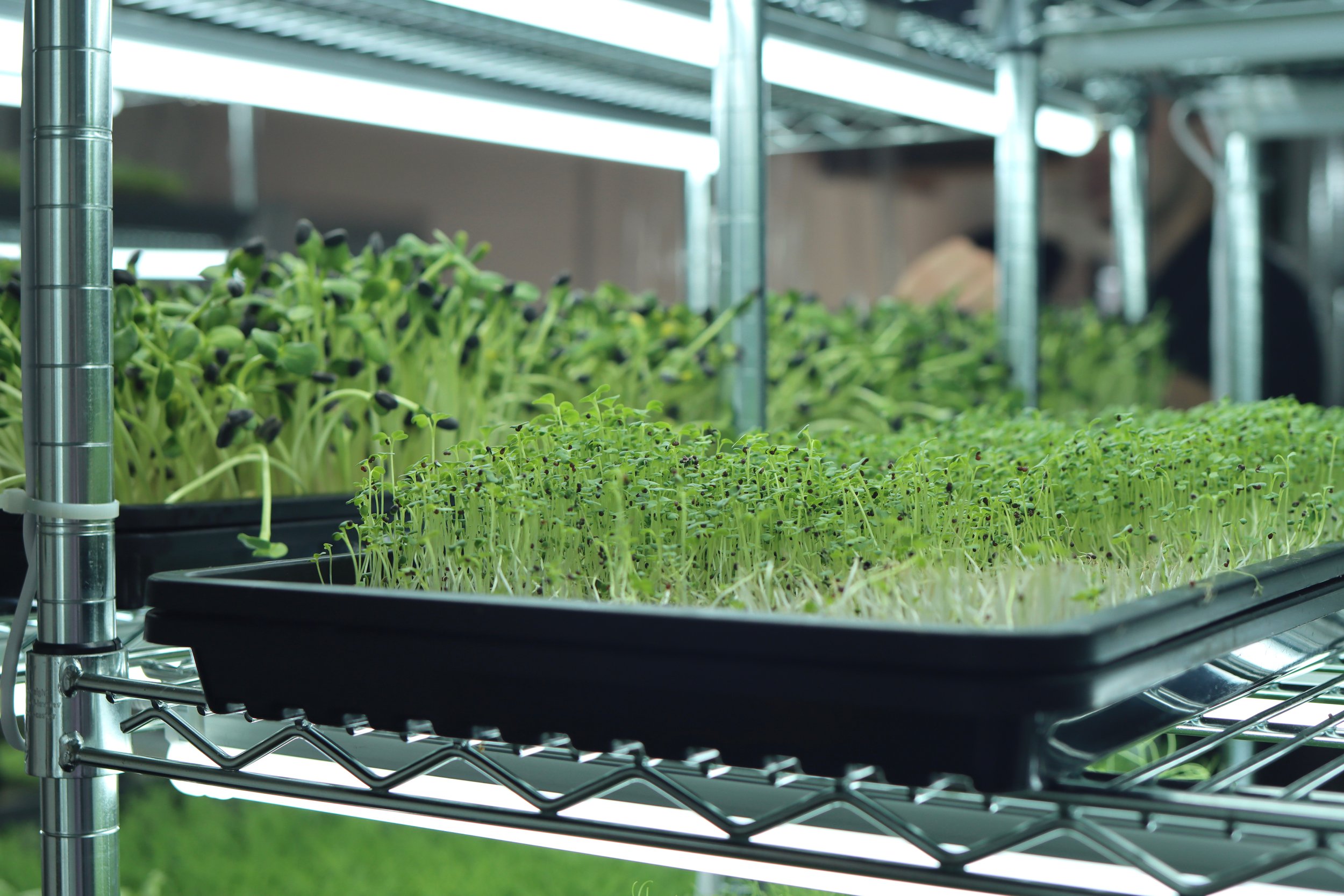The Real Farm in Chalk Farm
Come out of Chalk Farm’s glossy burgundy-brown station and hang a right. If you are peckish, and thinking about picking up a guilty pizza at the local, you might be in for a surprise. On the previous site of a Domino’s, surrounded incongruously by a wall of bright graffiti, several awkward junctions, a soulless block of flats, scaffolding and a classic London pub advertising ‘Cool Clear Courage’ alongside ‘Wines’, you will find… a farm.
Gone is the window plastered with cheap junk-food deals. Instead you’ll find trays of what looks like grass, stacked floor to ceiling. Sprigs Farm, as it is officially named, blossomed out of the gloom of last year. It is the brainchild of one Tom Pannett (former insect farmer determined to become the antithesis to the massive-scale agriculture industry of his native East Yorkshire), and Jonny Andrews (botany geek and ‘a bit of an ecomaniac’ who spent most of his career in tech start-ups). Together, they are UKs pioneers of vertical farming who met in the kind of serendipitous way that is only possible in London. ‘I got this unit in April, and it’s become our blueprint. Find cheap, disused buildings that aren’t necessarily good for other uses.’ Says Tom.
‘I saw him coming out and said, “What’s going on here!’ I had an office upstairs.’ Continues Jonny. ‘He told me what was going on and I geeked out.’
‘We went to the pub and talked and got plastered. You moved your desk down here and-’
‘Never left!’ Finishes Jonny, triumphantly.
The inside of Sprigs looks like it could be a murder room, with its transparent plastic curtains and hose for the floor. Or a school science lab, with its LED lighted racks and chalk board. Or even a garden centre, with its stacks of fluffy green shoots. What it does not look like is the tractor-and-cow farm of our childhood cartoons.
‘People talk about rolling fields’, says Jonny, ‘and that always cracks me up. You see those majestic photographs… but it’s actually a giant ecological desert with a monoculture where everything is killed by machines.’
‘None of it is natural, but it’s ingrained.’ Explains Tom, ‘That’s part of what we’re trying to do here: show there’s evolution in farming.’
Growing microgreens has been hailed as the future of food, since the controlled environment means no seasons…
Vertical farming, the practice of growing crops in upwards layers, is still very new. In America, Elon Musk’s brother leant his name to the process when he started vertical farms in New York, but the London scene has yet to find its celebrity champion.
‘At the moment we grow microgreens, which are quite a big thing in the US and Canada already. They’re baby versions of a full-grown plant, which we harvest at about 10 – 12 days old. This means we have a really fast turnaround of crops, never grow more than we need, and the seeds are cheap.’ So far, Sprigs Farm has trialled over 100 different varieties, though it has a core offering which is the most popular. These include: pea shoots, sunflower shoots, radish, broccoli, garlic, chives and coriander.
Growing microgreens has been hailed as the future of food, since the controlled environment means no seasons; hydroponics means the plants run zero risk of being contaminated with dirt; and these tiny seedlings pack an incredibly powerful punch of nutrients. Far, far more than supermarket salads. They know because they can measure the nutritional value.
‘We don’t use pesticides at all’, Jonny tells us, ‘even organic crops are still sprayed with chemicals. ‘Organic’ is just a legal definition. We only use fermented seaweed juice as fertilizer.’ They don’t even use soil, opting instead for beds made of recycled clothing that are made specially for greens to sprout on. When they are done, the grow felt is sent back to be reprocessed, then is reused by Sprigs again, keeping their low waste pledge.
Traditional farming grows speculatively, meaning they guess how much they’ll need and often end up throwing vast quantities away (an estimated 3.6 million tonnes, or 1.2 billion quid, is discarded every year on British farms). The obstacle vertical farming faces however, is food culture. ‘What we’ve found selling directly to the general public is that we have to educate,’ Tom notes, ‘That’s why Farmers Markets are so good. There’s an amount of explaining we have to do before people buy, because it’s such a new thing. “What do I do with that?” is what I’m always hearing.’
‘It’s tasty too,’ affirms Jonny, ‘my kids sit down and eat these sunflower shoots like they’re popcorn.’ And he’s right. From the peppery tang of radish, to the stunning nutty sweetness of sunflower, to the lemony freshness of basil, microgreens are nothing if not flavourful.
It’s not a mad science, it’s really simple stuff.
‘There’s plenty of food here,’ Jonny continues, ‘yet large areas of London are considered nutritional deserts. We’ll never take a big space because we want to spread our farms throughout the city for greater access. There used to be a pub and a church on every corner, we want there to be a farm!’
This ethos shows why their shopfront is important. If people see it, walk past, pop in and ask questions, Sprigs can slowly educate entire communities. They hope to also publish recipes and host workshops to further the message. ‘Sometimes people are sceptical because they think it’s somehow artificial. But the second you come in and start eating, it’s no longer a mystery. It’s not a mad science, it’s really simple stuff.’
To learn more about Sprigs Farm, please visit their website




